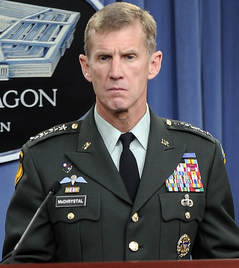Our recent columns have shared the risk management approach of Paul O’Neill and his conviction that to turn the company around, Alcoa had to create a learning-based culture that would embrace the pursuit of goals set at the level of known possibility. We now explore how retired U.S. Army General Stanley McChrystal used the same approach to defeat Al Qaeda and the broader implications for the field of risk management.
Thomas Jefferson, 1816

To further elucidate and validate O’Neill’s risk management approach, we turn now to the example of retired four-star U.S. Army General Stanley McChrystal. McChrystal assumed command of the Joint Special Operations Task Force in 2003 – at a time when the United States was trying to address the threat posed by instability and terrorism fomented by Al Qaeda in Afghanistan and Iraq. In some ways, the challenges (radicalization, insurgency etc.) were as old as time but the threat was new (remember how it felt on September 11, 2001) and the operating environment was different. Al Qaeda’s organizational structure was a dispersed network that was information-rich, densely interconnected, and highly mobile such that it operated with unprecedented speed that created risks that were different from anything McChrystal or his troops had ever experienced or trained for. As he assumed command and looked over the events of 2003 (transition from a conventional military campaign to overthrow Saddam Hussein to addressing the threat of Al Qaeda), McChrystal gained a fundamental insight: he and his forces were not prepared for the situation on the ground and never would be. In fact, it was like being a football team being told to play basketball mid-way through a game and learning that “habits and preconceptions had to be discarded along with pads and cleats.”
Put simply, despite an abundance of resources, the Task Force was simply not keeping up with the ever-changing threats posed by Al Qaeda. At the time McChrystal assumed command, the Task Force could only manage 10 to 18 raids per month. He likened the disparity in pace and speed to Germany (Al Qaeda) outflanking France (the Task Force) and the impenetrable French Maginot Line (a modern-day version of the Great Wall of China). The Maginot Line worked as designed – preventing the trench warfare of World War I – but it was outdated for a new military environment of tanks, airplanes and an enemy command that did not play by the rules. Similarly, McChrystal realized that the Task Force was fighting a 21st century war with a 20th century approach that could not respond quickly enough to Al Qaeda’s shape-shifting quality to transform itself at will.
The change in McChrystal’s thinking mirrors Paul O’Neill’s evolution as a leader and is summed up in the phrase: From Command to Team. That is, much like how O’Neill recognized the need to engage the entire workforce to keep Alcoa competitive, McChrystal also realized that he had to change his leadership approach. Since the Industrial Revolution, the prevailing leadership model throughout society (business, education, military) has been hierarchical and rooted in planning and prediction. Planning and prediction remain valuable tools but when the pace and complexity of change keeps growing (e.g., ever-expanding interactions and interdependencies that allow viruses and bank runs to spread), a different leadership approach is required, especially when the rate of change makes the world increasingly unpredictable and uncertain.
If prediction and planning are not the only way to address risk, how does an organization practice speed learning in the 21st century? McChrystal’s answer was to help the Task Force develop skills in adaptability and resilience thinking. This meant the Task Force, like any organization confronting stratification and silos, had to become a true learning network or in McChrystal’s words: “a team of teams.” The objective was to fuse the specialized expertise offered by various teams in the Task Force (e.g., Navy Seals, Army Rangers etc.) with everyone in the Task Force having generalized awareness of the entire, interconnected Task Force and the operating environment. McChrystal described this state of emergent, adaptive organizational intelligence as “shared consciousness.”
McChrystal’s method for achieving shared consciousness was to create a culture and system of information-sharing throughout the entire Task Force. Much like how O’Neill created a global and transparent system at Alcoa for observing, documenting and sharing safety issues on a real-time basis, McChrystal did the same and his favorite method was the daily Operations and Intelligence briefing (O&I). At the beginning of McChrystal’s command, the daily O&I was a small video teleconference between rear headquarters at Fort Bragg, a few agencies in Washington D.C., and a couple of large military bases in Iraq and Afghanistan. This type of O&I reflected a need-to-know mindset – an outdated model (from the predictability and planning era) built on the premise that somebody (typically the leader) actually knows who does and does not need to know which material. Over time, McChrystal changed the O&I so that every member of the Task Force could participate, and he structured the format so that all members of the organization could see problems being solved in real time through discussion and collaboration. By the end of his command, 7,000 people were attending the daily O&I because the information was so rich, so timely and so pertinent to the daily fight, no one wanted to miss it.
The shared consciousness approach worked. Three years into his command, 10 to 18 raids per month had increased to 300 raids per month, none of them approved by McChrystal. With minimal increases in personnel and funding, the Task Force was operating 17 times faster and achieving much greater success in finding a higher percentage of targets. In short, the Task Force was now able to learn and move as fast as Al Qaeda; it was excelling at speed learning. For those seeking more detail on McChrystal’s story, we recommend reading his book entitled Team of Teams, New Rules of Engagement for a Complex World (2015). Let’s now take a closer look at the leadership traits displayed by McChrystal and O’Neill and explore why an evolution in business leadership is critical to the future of risk management.


 RSS Feed
RSS Feed